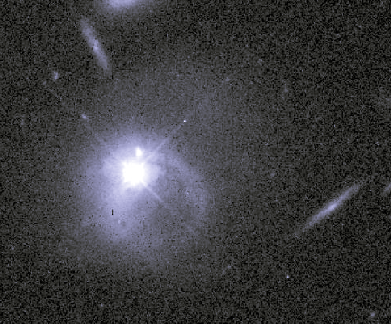Explanation: In 1963 astronomers were astounded to discover that certain faint, star-like objects have very large redshifts. The large redshifts imply that these objects, now known as quasars (QUASi-stellAR objects), lie near the edge of the observable Universe. To be visible at such extreme distances of billions of light years, they must emit tremendous amounts of energy. Where does the energy come from? In the most widely accepted model, a quasar is the bright nucleus of an active galaxy powered by a central, supermassive black hole. This Hubble Space Telescope image shows a quasar known as PKS 2349 (the star-like object near the center) and a galaxy (surrounding fuzzy patch), but the quasar is not at the galaxy's center! In fact, the galaxy and quasar seem to be colliding or merging. This and other recent HST observations suggest that astronomers' standard ideas about quasars may be wrong.
Authors & editors:
Robert Nemiroff
(MTU) &
Jerry Bonnell
(USRA)
NASA Web Site Statements, Warnings,
and Disclaimers
NASA Official: Jay Norris.
Specific
rights apply.
A service of:
LHEA at
NASA /
GSFC
& Michigan Tech. U.
Based on Astronomy Picture
Of the Day
